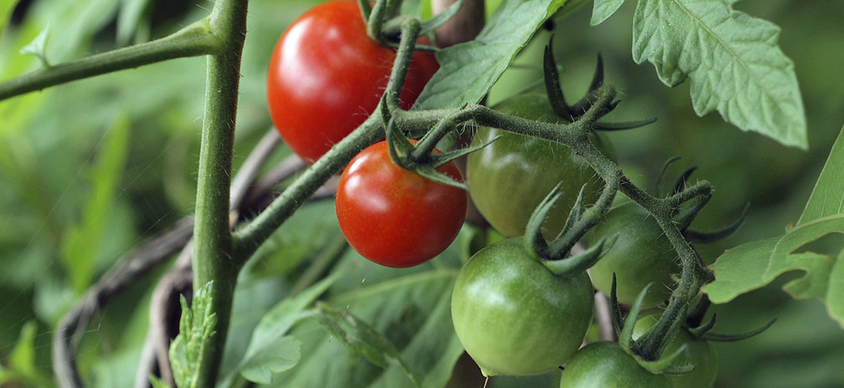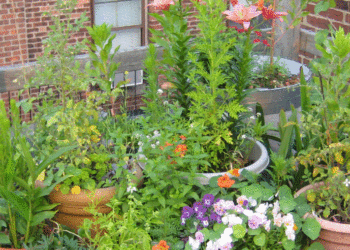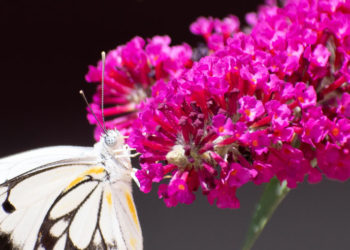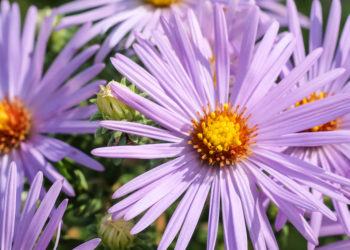Tomatoes are the most widely grown vegetables in home gardens. Thriving in warmth, tomatoes are happy both in garden plots and in pots on patios. They are usually the first vegetable plant that beginner gardeners grow. But what happens when you run into tomato plant problems? Arm yourself by learning about the most common problems (and the SOLUTIONS). And get ready for a successful growing season!
10 Common Tomato Plant Problems
Blossom-End Rot
Often called End Rot, Tomato End Rot or BER, it’s often the most common tomato problem for home gardeners. It appears as a leathery, brownish area that is indented on the blossom end of the tomato. It can be anywhere from the size of a dime to about the size of a half dollar. Fluctuations in moisture levels combined with a calcium deficiency will usually result in BER. Providing consistent moisture to your tomato plants and mulching to maintain moisture levels will help. Also ensure that you have the proper amount of calcium for all of your garden plants.
Tomato Skins Splitting or Cracking
This is one of the more unsightly tomato plant problems, but the tomatoes will still be edible. Cracking or splitting usually occurs because of sudden accelerated growth. It can happen due to a sudden increase in moisture after a dry period. It can also occur when the fruit is overripe. Providing consistent moisture and planting hybrid varieties that are less prone to cracking may solve the problem. Cherry tomatoes are the most prolific sufferers of cracking. Picking them when they are ripe or almost ripe, just before a predicted rain storm, will often prevent these from cracking.
Tomato Hornworm
Seeing chewed up leaves? Fruits that are still unripe but damaged? Start scouring your plants for tomato hornworms. They’re able to blend in to your tomato plants, but once you see one you will wonder how in the world you ever missed seeing it to begin with. They are HUGE and one of the ugliest, grayish-greenish wormy looking things you’ll ever see. There are a few companion plants you can plant to discourage hornworms. You can plant marigolds, dill, or basil. You can also do things that will invite birds to your garden. Put out bird feeders, bird baths and bird houses. Ladybugs, wasps and lacewings will eat the hornworm eggs. Here is a list of the most beneficial insects and how to attract them to your garden.
Yellow Leaves
If the leaves are uncurled and yellowing at the bottom of the plant, it may actually be a sign of the plant starting to die off at the end of the season. But if it occurs while your plant is still actively blooming or early in the season, you most likely have a nitrogen deficiency. Yellow leaves can also be an early sign of other problems like a pest, a fungus or bacterium. Your first step should be to use a soil tester to determine if it is a nitrogen deficiency. If it is, use a nitrogen-rich supplement to increase the amount of nitrogen. You can practice some prevention by preparing your soil with good organic material or compost before you plant.
Late Blight
This blight develops as water-soaked patches that turn brown and appear dry and papery. The fungus is normally present when the weather is very wet and the spores can travel long distances, infecting very large areas. You can prevent Late Blight by rotating your crops every year and by maintaining good air circulation around your plants. If you think that you have Late Blight, remove all the diseased stems, leaves and fruit and throw them away. You shouldn’t put them in the compost pile. In fact, if your plants are severely infected, you may have to dispose of all of your plants. If you think your plants are salvageable, you might try some Bonide Copper Dust.
Early Blight
This is a fungus that survives the winter on old vines and then rears its ugly head on your new plants. The best solution is to clean up old vines when the season ends. Then rotate your planting areas and space the plants according to recommendations to allow for good air circulation. You will know it’s Early Blight when you see blackish-brownish spots on tomato leaves, the leaves start to drop off or you have “sunburned” fruit. If caught early, you can use Bonide Copper Dust. It can be used as either a dust or a spray and is an organic solution to Early Blight and many other diseases.
Flowers Form But Drop Before Fruiting
This is typically due to unexpected weather changes. If nighttime temperatures drop below 55°F or if daytime temps are higher than 95°F with nighttime temperatures that don’t drop below 75°F, you may have a much larger occurrence of blossom drop. If the plant is not blooming during these periods, you have nothing to worry about. Mulch can help to keep the moisture level in your garden adequate for the plants. If the hot temps are occurring at the same time as hot, drying winds, mulching is important.
Shiny, Sticky & Deformed Leaves
This condition can be the result of aphids, whiteflies or spider mites. Aphids are the most common. They suck the plant sap and excrete a sticky substance on the leaves and fruit. They tend to congregate either on the top growth or the undersides of the leaves. They’re small, dark, pear-shaped insects. Spider mites will cause bunches of small yellow specks and spin fine webs on the leaves, making them feel sticky. Whiteflies, on the other hand, will actually fly when you brush the plant. If you shake the plant, they may look like dust. So, how do you deal with them? Keeping your tomato plants well-weeded will help, to some degree. But you may want to consider an insecticidal soap.
Fusarium and Verticillium Wilt
Both of these are caused by an incurable fungal infection. Once a plant has either one, you should dispose of the plant immediately. Be sure it goes in the garbage; do not add to the compost pile. You will recognize Fusarium Wilt when the leaves on one branch of the infected plant start wilting and then turn yellow. Verticillium Wilt is noticeable as yellowing starts appearing between the major veins on already mature leaves. The only way to avoid either of these is to select a hybrid variety that is resistant to wilt or to buy your plants from a very reputable grower. Almost without fail, these two types of wilt will occur in plants from a large retailer that doesn’t specialize in gardening.
Nematodes
This insect is almost invisible. They live under the soil and cause the root of the plant to swell. The only sign will be stunted plants and discolored leaves. These microscopic eelworms are soil-born, so there is no “cure” for them. Your tomato plants will still bear edible fruit, but once you’ve discovered the culprit, you will have to wait until next year to address the problem. One of the most common fixes is to plant marigolds with your tomatoes. They look pretty and killing Nematodes is not the only beneficial reason to plant marigolds. You might try “Nema-gone”, “Golden Guardian” or “Tangerine”. These varieties, among others, release a chemical into the soil that kills Nematodes. There are also many plants that you can “companion” plant that will “help” the tomato plant.
I’ve grown tomatoes and had none of these problems on a good year and multiple problems on a bad year. I’ve learned that soil quality and paying a bit of daily attention to my tomato plants will yield the best crop. Here’s wishing you many beautiful and yummy tomatoes!





11 Comments
10 Most Common Tomato Plant Problems - Plant Care Today
June 11, 2013 at 7:00 am[…] 10 Common Problems Growing Tomato Plants […]
Carmelo D Verdan
July 17, 2013 at 3:52 amThis problems in Tomato will not happen if you will only use the technology that we are using here in the Philippines the Biological and Nutrition Farming wherein we use the micronutrient as our foliar fertilizer spray and drench…
jstutzman
July 17, 2013 at 8:51 amCarmelo, can you be a bit more specific about what you use and how often you use it?
Karen
March 15, 2014 at 8:40 pmLast year I had beautiful lush tomato plants growing in a brand new raised bed with organic soil and mulch, we went on vacation for seven days and came back to dead and dying plants from late blight. Sometimes you can’t win!
jstutzman
March 16, 2014 at 4:45 pmSorry to hear that Karen. There is an organic product called Serenade Garden, you spray it on your plants once per week and it stops blights from happening. Good luck with your tomatoes this year!
The 10 Most Common Tomato Plant Problems Self Sufficiency Magazine
April 10, 2014 at 6:15 am[…] 10 Most Common Tomato Plant Problems […]
Warren
September 1, 2016 at 3:58 pmThe leaves on my tomato plants have started to curl a little and there is a white substance that looks like fine salt. It is now on 4 plants. Any ideas on what it is? Thanks in advance .
jstutzman
September 1, 2016 at 5:31 pmWarren, without seeing a photo one cannot be sure; however it sounds like powdery mildew. It thats what it is, the tomato plant needs more air circulation. It also helps to trim off the bottom leaves. You could also apply copper dust to stop the mildew.
Pat. Dirr
November 2, 2020 at 7:57 pmVery goof information.well written. Easy to process.
GrowJoy Plants
November 5, 2020 at 1:33 pmThank you Pat!
Sarah McCrary
May 19, 2021 at 2:43 pmLove your article!! Very informative, answered many questions i had about soil quality. Thank You
From Alabama USA